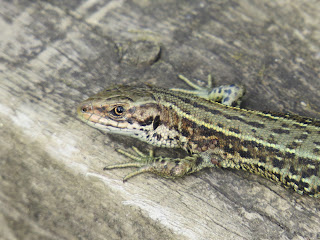 |
| Black-headed Gull with chick |
There seemed to be baby birds everywhere at Titchwell today. From Island Hide, black-headed gull chicks were like cute balls of fluff closely guarded by their noisy parents that chased anything that got too near to them. We saw an avocet chick from one of the Parrinder hides, wandering around by itself with full confidence and independence. And, of course, there were ducklings and goslings that would make anyone weak at the knees due to their adorableness.
 |
| Black-headed Gull chick |
 |
| Pochard with ducklings |
 |
| Mallard ducklings |
 |
| Avocet chick |
 |
| Greylag with goslings |
 |
| Little Gull |
Thankfully, if you are too manly for all this cute stuff, there were some great birds to see at this reserve today. My bird of the day was the little gull which swam close to the sea wall path from the freshwater marsh. Little gulls are indeed little gulls, a bit like a miniature version of a black-headed gull. Because of their size, it is hard to mistake them for any other gull, especially when they reveal their dark under wings. This one, I think, is still an immature bird from last year due to the dark markings on it's upper wings. I also saw avocets, black-tailed and bar-tailed godwits, a red-crested pochard, common terns, oystercatchers, shelducks, teal, gadwalls, shovelers, marsh harriers, skylarks, reed buntings, meadow pipits and a little ringed plover.
 |
| Little Ringed Plover |
 |
| Avocet |
 |
| Black-tailed Godwit |
 |
| Black-tailed Godwits |
 |
| Bar-tailed Godwits |
 |
| Redshank |
 |
| Red-crested Pochard |
 |
| Common Terns |
 |
| Black-headed Gull |
 |
| Moorhen |
 |
| Skylark |
 |
| Reed Bunting |
 |
| Woodpigeon |
 |
| Some kind of sand-dwelling spider |
At the beach, I went for a short walk along the dunes in search for a scarcer cousin to the green tiger beetles that I see at Mousehold Heath. Dune tiger beetles look just similar to a green tiger beetle, but are brown not green and are found only in a few scattered places across the UK with North Norfolk being one of their main hotspots. Unfortunately, despite scanning the dunes in the short time I had, I could not find a single beetle, just lots of dune-loving flies that kept pretending to be one, which fooled me constantly. I also found this spider, which I think is a sand-dwelling species as it never strayed from it's burrow in the sand and there was this small wasp, which I think is a species of spider-hunting wasp. Oh, and not forgetting the wall brown butterfly that I saw, another equally scarce insect these days.
 |
| A Spider-hunting Wasp of some kind |
 |
| Wall Brown |
After lunch, I went to the gate at the back of the car park area to look for one of the pair of turtle doves that has been nesting in the surrounding hedgerows. The gate overlooks a small ploughed field which the birds regularly visit to feed from. However, I was unable to find or even hear them today. But I wasn't disappointed as something better turned up, something that very few people, I expect, have seen alive before (me included).

While scanning the field for turtle doves, I heard something rustling under the hedge beside the gate. I was wondering what was making the noise. A bird? A mouse? No. It was a mole! I turned my head in time to see it dash under the gate and plunged under the surface of the soil. I ended up following it as the ground constantly bulged upwards as it moved. It was amazing to watch as it covered about several metres from the gate with ease. The way it moved was as if it was swimming underground. I stopped a few people who came for the doves to see the mole at work. Only one man stayed on to watch it with me as the mole made a U-turn and made it's way back to the gate. It then launched itself out of the soil and dashed with weasel-like speed back under the hedge. I had no idea moles were so fast! I was not prepared for it's quick pace and so I missed out on a photograph. It is something I won't be forgetting in a hurry, that's for sure!
























































































